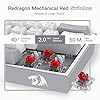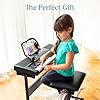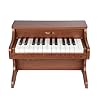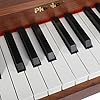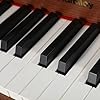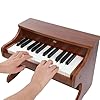Table of Contents
Introduction to Learning Piano Through Songwriting
The journey of mastering the piano can take various forms, with each method offering unique benefits and challenges. One innovative approach is learning piano through songwriting. This method not only improves your technical skills but also enhances your creative abilities. In this introductory guide, we explore how the interplay between songwriting and piano playing can provide a comprehensive learning experience that is both engaging and effective.
I-IV-V-I Progression
This basic chord progression is foundational in Western music, often used in various genres. It involves the tonic (I), subdominant (IV), and dominant (V) chords based on the scale of the chosen key. For example, in the key of C major, this progression would be C (I), F (IV), G (V), and back to C (I). This sequence is renowned for its strong resolution and ease in establishing a clear musical key, making it excellent for beginners on the piano.
Piano Adventures - Level 2A Lesson Book
$6.99 (as of December 13, 2025 13:37 GMT -08:00 - More infoProduct prices and availability are accurate as of the date/time indicated and are subject to change. Any price and availability information displayed on [relevant Amazon Site(s), as applicable] at the time of purchase will apply to the purchase of this product.)The Piano Proficiency Exam Review Book
$14.57 (as of December 13, 2025 13:50 GMT -08:00 - More infoProduct prices and availability are accurate as of the date/time indicated and are subject to change. Any price and availability information displayed on [relevant Amazon Site(s), as applicable] at the time of purchase will apply to the purchase of this product.)P71 Digital Piano Review and Guide
$0.00 (as of December 13, 2025 13:27 GMT -08:00 - More infoProduct prices and availability are accurate as of the date/time indicated and are subject to change. Any price and availability information displayed on [relevant Amazon Site(s), as applicable] at the time of purchase will apply to the purchase of this product.)Final Exam Review (Piano Collection)
$1.29 (as of December 13, 2025 13:50 GMT -08:00 - More infoProduct prices and availability are accurate as of the date/time indicated and are subject to change. Any price and availability information displayed on [relevant Amazon Site(s), as applicable] at the time of purchase will apply to the purchase of this product.)ii-V-I Progression
The ii-V-I progression is the most common chord sequence in jazz and also appears frequently in other music genres. It offers a smooth, cyclic progression that helps in developing a strong sense of movement. In the key of C major, this would be Dm (ii), G (V), and C (I). This progression is crucial for practicing transitioning between chords and exploring the relationship between minor and major harmonies.
I-vi-IV-V Progression
Also known as the 50s progression because of its prevalence in the doo-wop hits of the 1950s. This progression involves the tonic (I), the sixth chord (vi), the subdominant (IV), and the dominant chord (V). For a key of G major, the progression would be G (I), Em (vi), C (IV), and D (V). It creates a nostalgic and sentimental sound, ideal for beginners interested in composing more emotive music pieces.
I-V-vi-IV Progression
A highly popular and versatile chord progression used across various music genres, from pop to rock, and beyond. This sequence includes the tonic (I), dominant (V), sixth (vi), and subdominant (IV). In the key of C major, this would translate to C (I), G (V), Am (vi), and F (IV). This progression is renowned for its emotional impact and is a staple in modern music composition.
How to Create Melodies on the Piano
Creating melodies on the piano involves combining musical elements like pitch, rhythm, and harmony to form a musical phrase that is appealing and memorable. Here are some key steps and tips to consider when composing your own melodies:
Redragon Mechanical Gaming Keyboard Wired, 11 Programmable Backlit Modes, Hot-Swappable Red Switch, Anti-Ghosting, Double-Shot PBT Keycaps, Light Up Keyboard for PC Mac
40% OffLogitech K270 Wireless Keyboard for Windows, 2.4 GHz Wireless, Full-Size, Number Pad, 8 Multimedia Keys, 2-Year Battery Life, Compatible with PC, Laptop, Black
33% OffRedragon K617 Fizz 60% Wired RGB Gaming Keyboard, 61 Keys Hot-Swap Compact Mechanical Keyboard w/White and Grey Color Keycaps, Linear Red Switch, Pro Driver/Software Supported
$44.99 (as of December 13, 2025 16:23 GMT -08:00 - More infoProduct prices and availability are accurate as of the date/time indicated and are subject to change. Any price and availability information displayed on [relevant Amazon Site(s), as applicable] at the time of purchase will apply to the purchase of this product.)EPOMAKER x Aula F75 Gasket Mechanical Keyboard, 75% Wireless Hot Swappable Gaming Keyboard with Five-Layer Padding&Knob, Bluetooth/2.4GHz/USB-C, RGB (Light Blue, LEOBOG Reaper Switch)
15% OffBefore diving into melody creation, a basic understanding of music theory is essential. Familiarize yourself with scales, chords, and intervals. These are the building blocks of any melody. Start with major and minor scales as they are the foundation of most popular and classical music.
A motif is a short musical idea, consisting of a sequence of notes that can be developed and repeated throughout a piece. Think of a motif as the basic “cell” of your melody. It could be anything from a simple series of notes to a rhythmic pattern.
Rhythm plays a crucial role in creating an engaging melody. Change up the rhythm of your motif by introducing syncopation, rests, and varying note lengths. This can help create interest and movement in your melody.
Once you have a motif, begin to expand it into a fuller melody. Play around with ascending and descending intervals, repeat your motif at different pitches, and alter it slightly each time to keep it interesting. A good melody will often move in a way that is somewhat predictable yet surprising.
Harmony supports the melody and can enhance the emotional impact of your piece. Add chords under your melody to provide depth and context. Experiment with different chord progressions and observe how they change the character of your melody.
After establishing your basic melody supported by harmony, introduce variations. Alter the pitch, rhythm, dynamics, or harmonic support to see how it changes the feel and effect of the melody. Variation keeps the listener engaged and makes your composition more dynamic.
In today’s digital age, various software tools can help you craft and refine melodies. Using piano roll editors in music production software, you can visually manipulate notes and their timing, which can be helpful in fine-tuning your melodies. Recording your melodies and listening back can also provide a new perspective and inspire further development.
Sharing your melodies with others can provide valuable feedback. Use this input to improve and refine your melodies. Don’t be afraid to make substantial changes based on what you learn from others’ reactions.
Always be ready to capture musical ideas. Whether you use a traditional recorder, a smartphone app, or even jotting down notes on paper, keeping track of musical ideas as they come can serve as a valuable repository when you sit down to compose.
The more you practice creating melodies, the more intuitive and enjoyable the process will become. Regular practice helps you internalize musical structures and ideas, making melody creation more fluid and spontaneous over time.
Using the Piano to Develop Song Structure
Developing a song structure using the piano involves exploring various musical elements that can be organized into a cohesive composition. The piano’s versatility in harmony, melody, and rhythm makes it an excellent tool for songwriters to craft and refine the structure of their songs.
Starting with a Basic Chord Progression
The foundation of many songs lies in its chord progression. Beginners can start by learning simple chord progressions such as the classic I-IV-V progression. Use the piano to experiment with these chords in different keys to find the sound that best suits the song’s mood and theme. Progression variations and modulations can be added later to enhance the musical journey.
Building Melodies on the Piano
Melody is what often catches the listener’s ear. On the piano, songwriters can explore melodies by playing scales and improvising within the chosen key. It’s crucial to understand how melodies interact with underlying chord progressions. The goal is to create a melody that is memorable and fits seamlessly over the piano’s harmonic base. Use techniques like repetition, sequence, and variation to develop a compelling melody line.
Incorporating Rhythmic Elements
Rhythm adds energy and pace to songwriting. The piano allows composers to experiment with different rhythms against their chord progressions and melodies. This might include altering the tempo, adjusting the timing of chord changes, or playing with syncopation to add interest. Understanding rhythmic phrasing on the piano helps in structuring different sections of the song effectively.
Creating Song Sections
Songs typically consist of verses, choruses, and possibly a bridge or solo sections. Use the piano to outline each section, ensuring they contrast yet complement each other in terms of melody, harmony, and rhythm. For instance, a chorus might feature a fuller chord structure or a higher melody line to differentiate it from verses. Experimentation on the piano can lead to innovative ways of transitioning between sections, such as through a key change or a unique rhythmic shift.
Utilizing Dynamic and Texture Changes
Dynamics and texture play a critical role in the emotional impact of a song. On the piano, dynamics can be managed through the intensity of key presses, whereas texture can be varied with pedal use, chord density, or even integrating arpeggios. These tools help indicate shifts in song intensity or mood, and can define different sections of the song more clearly.
Review and Refinement
After structuring the song, use the piano to play through the entire piece to review its coherence and impact. This is the time to refine transitions, adjust dynamics, and ensure that the melody and harmony are in sync. Recording the session can help to review the structure more critically and make necessary adjustments.
By repeatedly analyzing and refining the song structure using the piano, songwriters can achieve a well-balanced, engaging composition. The piano not only serves as a writing tool but also as an instrument for deepening one’s understanding of musical form and emotional expression.
Tips for Writing Lyrics that Match Your Music
Start with a clear concept: Before you begin writing lyrics, have a clear concept or theme in mind that is reflective of the emotions or story you want to convey through your composition. This will guide the narrative and emotional progression of your lyrics to ensure they are in harmony with the tone and style of your music.
Understand the structure of your music: Pay attention to the musical structure — verses, choruses, bridges — and plan your lyrics accordingly. Each part of your song should complement the dynamics and mood changes in your music. For instance, use short, repetitive phrases in the chorus for catchiness and longer, more narrative lines in the verses to tell your story.
Analyze the melody: Let the melody dictate the rhythm and flow of your lyrics. If the melody is fast and upbeat, your lyrics should match this energy, possibly with quicker syllable delivery. Conversely, a slow, contemplative melody might be best paired with deeper or more reflective lyrics.
Use imagery and metaphor: To enhance the emotional resonance of your song, use vivid imagery and metaphors that complement the musical elements. This creates a deeper connection between your lyrics and the listener, making the song more memorable and impactful.
Maintain lyrical consistency: Consistency in your lyric’s tone and language style is crucial. It ensures that the song feels cohesive from start to finish. If your music carries a particular mood or style, let your vocabulary and lyric tone reflect that throughout the song.
Consider phrasing and breath control: How your lyrics are phrased can significantly impact their effectiveness with the music. Consider where the vocalist needs to take breaths and ensure that your lyrical phrasing allows for comfortable singing while maintaining the natural cadence of the music.
Rewrite for refinement: Don’t hesitate to rewrite your lyrics. Often, the fit between lyrics and music improves when you fine-tune phrases, adjust word choices, or rethink the pacing of your lyrics to better match musical transitions and nuances.
Experiment with vocal melodies: Sometimes, playing around with the vocal melody can inspire fitting lyrics. Try humming or freestyling different melodies to your music before settling on your lyrics; this can provide new ideas and perspectives for how to write your lyrics in a way that complements the musical arrangements.
Collaborate with others: Collaboration can be a wonderful way to match your lyrics to your music. Working with another musician or lyricist can provide fresh insights and ideas that you might not have considered, helping you to find the perfect balance between your lyrics and music.
Recording Your Songs
Recording your piano songs can be a transformative part of the songwriting process, allowing you to hear your compositions played back and evaluate them with a critical ear. To start recording, you’ll need some basic equipment: a digital piano or a microphone, an audio interface, and recording software. Begin by setting up your space to minimize unwanted noise and ensure your piano is well-tuned.
When recording, aim to capture your performance as clearly and accurately as possible. Utilize multiple takes to explore different expressions and nuances in your playing. After recording, you can use your software to make essential edits such as trimming the recording, adjusting levels, and adding effects like reverb to enhance the piano’s natural sound.
Arranging Your Songs
Arranging your songs is crucial to developing the full potential of your musical ideas. An arrangement can transform a simple piano piece into a rich, textured composition. Consider the structure of your song, including the introduction, verse, chorus, bridge, and outro. Think about how you can use different piano techniques to highlight each section, such as varying your dynamics, altering your playing style, or incorporating arpeggios or chord inversions.
Beyond the piano, think about other instruments or sounds that might complement your piece. Software instruments and samples can be added to create layers and depth. For instance, strings can bring a dramatic flair to your chorus, or a soft synth pad can fill out the background subtly.
Lastly, be open to the idea of rearranging your pieces based on feedback or new inspirations that might strike after the initial composition phase. The process is dynamic and can continue evolving even after the initial recording sessions.
Conclusion
Integrating songwriting into piano learning can enhance creativity, reinforce musical theory, and increase engagement in students. This approach not only makes the learning process more enjoyable but also deepens students’ understanding of music by applying concepts in a practical and artistic manner. Although it may present challenges, such as the need for additional skills in lyric creation or composition, the benefits, including improved motivation and a deeper emotional connection to the music, far outweigh these hurdles. Overall, learning piano through songwriting is an effective method that could revolutionize traditional teaching methods and inspire a lifelong passion for music.
























